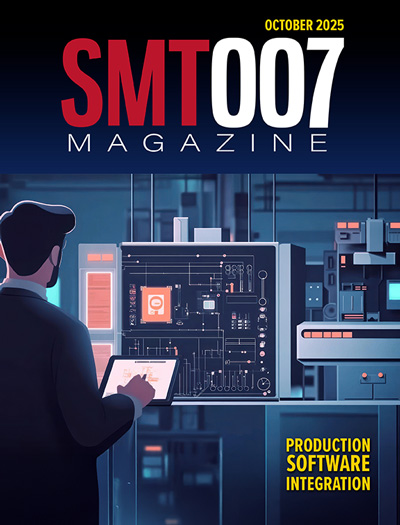-

- News
- Books
Featured Books
- smt007 Magazine
Latest Issues
Current Issue
Spotlight on Mexico
Mexico isn’t just part of the electronics manufacturing conversation—it’s leading it. From growing investments to cross-border collaborations, Mexico is fast becoming the center of electronics in North America. This issue includes bilingual content, with all feature articles available in both English and Spanish.

Production Software Integration
EMS companies need advanced software systems to thrive and compete. But these systems require significant effort to integrate and deploy. What is the reality, and how can we make it easier for everyone?

Spotlight on India
We invite you on a virtual tour of India’s thriving ecosystem, guided by the Global Electronics Association’s India office staff, who share their insights into the region’s growth and opportunities.
- Articles
- Columns
- Links
- Media kit
||| MENU - smt007 Magazine
Book Excerpt: The Printed Circuit Assembler’s Guide to... Low-Temperature Soldering, Vol. 2, Chapter 5
December 23, 2024 | I-Connect007 Editorial TeamEstimated reading time: 1 minute
By Morgana Ribas, Pritha Choudhury, Ramakrishna H V, and Rahul Raut, MacDermid Alpha Electronics Solutions
Chapter 5: Unveiling a Total Solution for Soldering Through-hole Components Using a Low-temperature Alloy
Electronic assembly developers have a myriad of material and process choices to make, and low- temperature soldering is a process increasingly being considered for various assembly needs. LTS is attractive for a range of advantages:
- Potentially reduces material cost by enabling the use of lower cost PCBs and components due to lower processing temperature
- Promotes long-term reliability by reducing exposure to thermal excursion
- Long-term reliability is promoted by improvement in micro-via lifetime performance
- Lower energy cost
- Lower dynamic warpage in sensitive components
- Improved memory cell retention in high-density memory products such as LPDDR5
Use of the same low-temperature alloy for solder paste and solid solder provides a total solution for assembling a wider variety of electronic packages, including through-hole components.
The key benefits of using a low-temperature alloy for through-hole components are:
- Enables the use of low temperature in selective soldering
- Enables soldering processes with heat-sensitive substrates, components, or board materials
- Provides efficiencies in both energy and cost versus standard lead-free alloys
- Reduction of warpage up to 99% (component and board/substrate) vs. SAC305 processes
- Comparable mechanical performance with SAC305 under certain conditions
- Cost effective
Solder joints are an essential part of electronic devices that provide an electrical connection as well as a mechanical and thermal bond. Increased digitalization and greater connectivity are driving factors for miniaturization and more complex and integrated designs in electronics. With shrinking real estate on the PCBs, package sizes continue to shrink and the demand for reliability only increases. The requirement for solders with higher thermal and electrical reliability is the most important technology driver for designing new soldering materials. The ability of soldering at lower temperatures needs to be balanced with the thermal and mechanical reliability requirements for a specific application. The higher reflow temperature required for soldering a hybrid solder joint involving SAC BGA can potentially result in soldering defects such as non-wet opens, solder bridging, head on pillow, and non-contact opens in packages such as Package on Package (PoP) bottom and PoP memory. Low-temperature soldering is becoming a crucial technology, as it helps prevent defects caused by warpage in ultra-thin, high I/O CSP packages used in complex electronic devices.
Testimonial
"We’re proud to call I-Connect007 a trusted partner. Their innovative approach and industry insight made our podcast collaboration a success by connecting us with the right audience and delivering real results."
Julia McCaffrey - NCAB GroupSuggested Items
Indium to Showcase High-Reliability Solder and Flux-Cored Wire Solutions at SMTA International
10/09/2025 | Indium CorporationAs one of the leading materials providers in the electronics industry, Indium Corporation® will feature its innovative, high-reliability solder and flux-cored wire products at SMTA International (SMTAI), to be held October 19-23 in Rosemont, Illinois.
‘Create your Connections’ – Rehm at productronica 2025 in Munich
10/08/2025 | Rehm Thermal SystemsThe electronics industry is undergoing dynamic transformation: smart production lines, sustainability, artificial intelligence, and sensor technologies dominate current discussions.
SASinno Americas Introduces the Ultra Series
10/07/2025 | SASinno AmericasSASinno Americas has introduced the new Ultra Series, the latest generation of offline selective soldering systems. Available in two models—the Ultra-i1 and Ultra-i2—the new series is designed to meet the needs of manufacturers running small to medium batch sizes, multiple product types, and frequent line changes, while maintaining exceptional precision and process control.
Elmotec by E-Tronix to Showcase SolderSmart® TOP Robotic Soldering at The Assembly Show 2025
10/06/2025 | ELMOTECE-tronix, a Stromberg Company, is pleased to announce its participation at The Assembly Show 2025 in Rosemont, IL, October 21st through 23rd. Exhibiting under Elmotec by E-Tronix, Booth #448, the team will highlight the SolderSmart® TOP robotic soldering system, featuring live demonstrations throughout the show.
SolderKing Marks Seven Years of Growth and International Recognition
10/01/2025 | SolderKing Assembly Materials Ltd,SolderKing Assembly Materials Ltd, a leading UK-based manufacturer of soldering materials and consumables, is celebrating seven years of innovation, growth, and international success.


